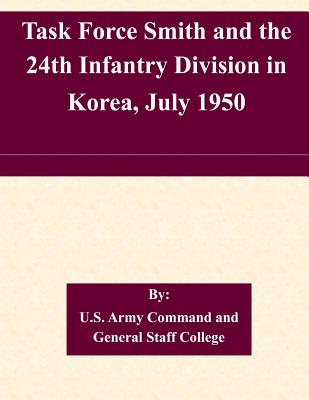Task Force Smith and the 24th Infantry Division in Korea, July 1950

Task Force Smith and the 24th Infantry Division in Korea, July 1950
When the 24th Infantry Division deployed to Korea in July 1950 it experienced a series of defeats from 5-20 July in an attempt to delay the invading North Korean People's Army (NKPA). The division suffered devastating losses of men and equipment and was withdrawn from combat because it was no longer capable of effective combat operations. Historians blamed the appalling losses and demoralizing defeats of 5-20 July on poor training, poor equipment, and lazy, ill-disciplined soldiers of an occupation army. The operational approach and the operational art of the commanders and staffs of the Eight Army and the 24th Infantry Division was the real cause of this reckless waste of American lives. They failed to employ their forces in accordance with their training, experience, and readiness and that of the enemy. Additionally, the gains the 24th Infantry Division achieved in delaying the NKPA were not decisive. The subsequent successful defense of the Pusan Perimeter occurred despite, not because of the 24th ID's delaying operation. This monograph explores the reasons for the 24th Infantry Division's defeats between 5 and 20 July. Although Eighth Army was not at an optimal state of readiness, it was sufficiently equipped and ready to conduct fundamental operational and tactical tasks. In modern warfare, technology and numerical preponderance are not the primary determinant of results; force employment is the primary cause of victory or defeat. Lastly, this monograph examines the operational art of the 24th Infantry Division and shows the small delays achieved were not decisive. The primary and immediate cause of failure was poor force employment and operational art. The 24th Infantry Division should have been able to delay two reinforced NKPA Infantry Divisions without suffering the devastating losses that it did.
PRP: 100.36 Lei
Acesta este Prețul Recomandat de Producător. Prețul de vânzare al produsului este afișat mai jos.
80.29Lei
80.29Lei
100.36 LeiIndisponibil
Descrierea produsului
When the 24th Infantry Division deployed to Korea in July 1950 it experienced a series of defeats from 5-20 July in an attempt to delay the invading North Korean People's Army (NKPA). The division suffered devastating losses of men and equipment and was withdrawn from combat because it was no longer capable of effective combat operations. Historians blamed the appalling losses and demoralizing defeats of 5-20 July on poor training, poor equipment, and lazy, ill-disciplined soldiers of an occupation army. The operational approach and the operational art of the commanders and staffs of the Eight Army and the 24th Infantry Division was the real cause of this reckless waste of American lives. They failed to employ their forces in accordance with their training, experience, and readiness and that of the enemy. Additionally, the gains the 24th Infantry Division achieved in delaying the NKPA were not decisive. The subsequent successful defense of the Pusan Perimeter occurred despite, not because of the 24th ID's delaying operation. This monograph explores the reasons for the 24th Infantry Division's defeats between 5 and 20 July. Although Eighth Army was not at an optimal state of readiness, it was sufficiently equipped and ready to conduct fundamental operational and tactical tasks. In modern warfare, technology and numerical preponderance are not the primary determinant of results; force employment is the primary cause of victory or defeat. Lastly, this monograph examines the operational art of the 24th Infantry Division and shows the small delays achieved were not decisive. The primary and immediate cause of failure was poor force employment and operational art. The 24th Infantry Division should have been able to delay two reinforced NKPA Infantry Divisions without suffering the devastating losses that it did.
Detaliile produsului









